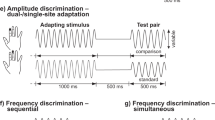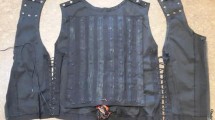Abstract
In this study, we investigated the changes in perceptual metrics of amplitude discrimination that were observed in ten healthy human subjects with increasing intensities of stimulation. The ability to perceive differences in vibrotactile amplitude changed systematically with increasing stimulus magnitude (i.e., followed Weber’s Law) in a near linear fashion (R 2 = 0.9977), and the linear fit determined by the amplitude discrimination task predicted the subjects’ detection thresholds. Additionally, the perceptual metrics correlated well with observations from a previously reported study in which measures of SI cortical activity in non-human primates (squirrel monkeys) evoked by different amplitudes of vibrotactile stimulation were obtained (Simons et al. in BMC Neurosci 6:43, 2005). Stimuli were delivered simultaneously to two different skin sites (D2 and D3), enabling a method for the relatively rapid acquisition of the data. Stability and robustness of the measure, its rapid acquisition, and its apparent relationship with responses previously observed in SI cortex, led to the conclusion that deviations from the baseline values observed in the obtained perceptual metric could provide a useful indicator of cerebral cortical health.




Similar content being viewed by others
References
Alary F, Goldstein R, Duquette M, Chapman CE, Voss P, Lepore F (2008) Tactile acuity in the blind: a psychophysical study using a two-dimensional angle discrimination task. Exp Brain Res 0014–4819 (Print)
Arthurs OJ, Williams EJ, Carpenter TA, Pickard JD, Boniface SJ (2000) Linear coupling between functional magnetic resonance imaging and evoked potential amplitude in human somatosensory cortex. Neuroscience 101:803–806
Backes WH, Mess WH, van Kranen-Mastenbroek V, Reulen JP (2000) Somatosensory cortex responses to median nerve stimulation: fMRI effects of current amplitude and selective attention. Clin Neurophysiol 111:1738–1744
Bruno RM, Khatri V, Land PW, Simons DJ (2003) Thalamocortical angular tuning domains within individual barrels of rat somatosensory cortex. J Neurosci 23:9565–9574
Chen LM, Friedman RM, Roe AW (2003) Optical imaging of a tactile illusion in area 3b of the primary somatosensory cortex. Science 302:881–885
Chiu JS, Tommerdahl M, Whitsel BL, Favorov OV (2005) Stimulus-dependent spatial patterns of response in SI cortex. BMC Neurosci 6:47
Connor CE, Hsiao SS, Phillips JR, Johnson KO (1990) Tactile roughness: neural codes that account for psychophysical magnitude estimates. J Neurosci 10:3823–3836
Favorov OV, Kelly DG (1996) Local receptive field diversity within cortical neuronal populations. In: Franzen O, Johansson R, Terenius L (eds) Somesthesis and the neurobiology of the somatosensory cortex. Birkhauser Verlag, Basel, pp 395–408
Folger S, Tannan V, Zhang Z, Holden J, Tommerdahl M (2008) Effects of the N-methyl-d-aspartate receptor antagonist dextromethorphan on vibrotactile adaptation. Submitted
Gescheider GA, Bolanowski SJ Jr, Verrillo RT, Arpajian DJ, Ryan TF (1990) Vibrotactile intensity discrimination measured by three methods. J Acoust Soc Am 87:330–338
Gescheider GA, Edwards RR, Lackner EA, Bolanowski SJ, Verrillo RT (1996a) The effects of aging on information-processing channels in the sense of touch: III. Differential sensitivity to changes in stimulus intensity. Somatosens Mot Res 13:73–80
Gescheider GA, Zwislocki JJ, Rasmussen A (1996b) Effects of stimulus duration on the amplitude difference limen for vibrotaction. J Acoust Soc Am 100:2312–2319
Gescheider GA, Thorpe JM, Goodarz J, Bolanowski SJ (1997) The effects of skin temperature on the detection and discrimination of tactile stimulation. Somatosens Mot Res 14:181–188
Gescheider GA, Berryhill ME, Verrillo RT, Bolanowski SJ (1999) Vibrotactile temporal summation: probability summation or neural integration? Somatosens Mot Res 16:229–242
Gescheider GA, Bolanowski SJ, Verrillo RT (2004) Some characteristics of tactile channels. Behav Brain Res 148:35–40
Goble AK, Hollins M (1993) Vibrotactile adaptation enhances amplitude discrimination. J Acoust Soc Am 93:418–424
Goble AK, Hollins M (1994) Vibrotactile adaptation enhances frequency discrimination. J Acoust Soc Am 96:771–780
Goble AK, Collins AA, Cholewiak RW (1996) Vibrotactile threshold in young and old observers: the effects of spatial summation and the presence of a rigid surround. J Acoust Soc Am 99:2256–2269
Goldstein EB (2007) Sensation and perception. Wadsworth
Guclu B, Bolanowski SJ (2002) Modeling population responses of rapidly-adapting mechanoreceptive fibers. J Comput Neurosci 12:201–218
Guclu B, Tanidir C, Mukaddes NM, Unal F (2007) Tactile sensitivity of normal and autistic children. Somatosens Mot Res 24:21–33
Hanna TE, von Gierke SM, Green DM (1986) Detection and intensity discrimination of a sinusoid. J Acoust Soc Am 80:1335–1340
Hollins M, Sigurdsson A (1998) Vibrotactile amplitude and frequency discrimination in temporomandibular disorders. Pain 75:59–67
Hollins M, Sigurdsson A, Fillingim L, Goble AK (1996) Vibrotactile threshold is elevated in temporomandibular disorders. Pain 67:89–96
Iguchi Y, Hoshi Y, Tanosaki M, Taira M, Hashimoto I (2002) Selective attention regulates spatial and intensity information processing in the human primary somatosensory cortex. Neuroreport 13:2335–2339
Johnson KO (1974) Reconstruction of population response to a vibratory stimulus in quickly adapting mechanoreceptive afferent fiber population innervating glabrous skin of the monkey. J Neurophysiol 37:48–72
Johnson KO, Hsiao SS, Yoshioka T (2002) Neural coding and the basic law of psychophysics. Neuroscientist 8:111–121
Kosek E, Ekholm J, Hansson P (1996) Modulation of pressure pain thresholds during and following isometric contraction in patients with fibromyalgia and in healthy controls. Pain 64:415–423
Llinas R, Sugimori M (1980) Electrophysiological properties of in vitro Purkinje cell dendrites in mammalian cerebellar slices. J Physiol 305:197–213
McCasland JS, Woolsey TA (1988) High-resolution 2-deoxyglucose mapping of functional cortical columns in mouse barrel cortex. J Comp Neurol 278:555–569
Mountcastle VB, Poggio GF, Werner G (1963) The relation of thalamic cell response to peripheral stimuli varied over an intensive continuum. J Neurophysiol 26:807–834
Nelson AJ, Staines WR, Graham SJ, McIlroy WE (2004) Activation in SI and SII: the influence of vibrotactile amplitude during passive and task-relevant stimulation. Brain Res Cogn Brain Res 19:174–184
Ofek H, Defrin R (2007) The characteristics of chronic central pain after traumatic brain injury. Pain 131:330–340
Rocheron I, Lorenzi C, Fullgrabe C, Dumont A (2002) Temporal envelope perception in dyslexic children. Neuroreport 13:1683–1687
Scholtyssek C, Kelber A, Dehnhardt G (2008) Brightness discrimination in the harbor seal (Phoca vitulina). Vision Res 48:96–103
Simons DJ (1978) Response properties of vibrissa units in rat SI somatosensory neocortex. J Neurophysiol 41:798–820
Simons SB, Tannan V, Chiu J, Favorov OV, Whitsel BL, Tommerdahl M (2005) Amplitude-dependency of response of SI cortex to flutter stimulation. BMC Neurosci 6:43
Simons SB, Chiu J, Favorov OV, Whitsel BL, Tommerdahl M (2007) Duration-dependent response of SI to vibrotactile stimulation in squirrel monkey. J Neurophysiol 97:2121–2129
Stillman JA, Zwislocki JJ, Zhang M, Cefaratti LK (1993) Intensity just-noticeable differences at equal-loudness levels in normal and pathological ears. J Acoust Soc Am 93:425–434
Tannan V, Dennis R, Tommerdahl M (2005) A novel device for delivering two-site vibrotactile stimuli to the skin. J Neurosci Methods 147:75–81
Tannan V, Whitsel BL, Tommerdahl MA (2006) Vibrotactile adaptation enhances spatial localization. Brain Res 1102:109–116
Tannan V, Dennis RG, Zhang Z, Tommerdahl M (2007a) A portable tactile sensory diagnostic device. J Neurosci Methods 164:131–138
Tannan V, Simons S, Dennis RG, Tommerdahl M (2007b) Effects of adaptation on the capacity to differentiate simultaneously delivered dual-site vibrotactile stimuli. Brain Res 1186:164–170
Tannan V, Holden JK, Zhang Z, Baranek G, Tommerdahl MA (2008) Perceptual metrics of individuals with autism provide evidence for disinhibition. Submitted
Tommerdahl M, Whitsel BL, Cox EG, Diamond ME, Kelly DG (1987) Analysis of the periodicities in somatosensory cortical activity patterns. Society for Neuroscience Abstracts 13:470
Tommerdahl M, Favorov O, Whitsel BL, Nakhle B, Gonchar YA (1993) Minicolumnar activation patterns in cat and monkey SI cortex. Cereb Cortex 3:399–411
Tommerdahl M, Favorov O, Whitsel BL (2002) Optical imaging of intrinsic signals in somatosensory cortex. Behav Brain Res 135:83–91
Tommerdahl M, Chiu J, Whitsel BL, Favorov O (2005a) Minicolumnar patterns in the global cortical response to sensory stimulation. In: Casanova MF (ed) Neocortical modularity and the cell minicolumn. Nova Science, Hauppauge, pp 145–160
Tommerdahl M, Simons SB, Chiu JS, Favorov O, Whitsel B (2005b) Response of SI cortex to ipsilateral, contralateral and bilateral flutter stimulation in the cat. BMC Neurosci 6:29
Tommerdahl M, Simons SB, Chiu JS, Favorov O, Whitsel BL (2006) Ipsilateral input modifies the primary somatosensory cortex response to contralateral skin flutter. J Neurosci 26:5970–5977
Tommerdahl M, Tannan V, Cascio CJ, Baranek GT, Whitsel BL (2007a) Vibrotactile adaptation fails to enhance spatial localization in adults with autism. Brain Res 1154:116–123
Tommerdahl M, Tannan V, Zachek M, Holden JK, Favorov OV (2007b) Effects of stimulus-driven synchronization on sensory perception. Behav Brain Funct 3:61
Tommerdahl M, Tannan V, Holden JK, Baranek G (2008a) Changes in sensory percept in autism: evidence for local under-connectivity? Behav Brain Funct 4:19
Tommerdahl MA, Tannan V, Holden JK, Baranek G (2008b) Absence of stimulus-driven synchronization effects on sensory perception in autism: evidence for local underconnectivity? Submitted
Torquati K, Pizzella V, Della Penna S, Franciotti R, Babiloni C, Rossini PM, Romani GL (2002) Comparison between SI and SII responses as a function of stimulus intensity. Neuroreport 13:813–819
Werner G, Mountcastle VB (1965) Neural activity in mechanoreceptive cutaneous afferents: stimulus-response relations, weber functions, and information transmission. J Neurophysiol 28:359–397
Whitsel BL, Kelly EF, Delemos KA, Xu M, Quibrera PM (2000) Stability of rapidly adapting afferent entrainment versus responsivity. Somatosens Mot Res 17:13–31
Wiacek R, Pielka S, Rutowski R, Gosk J, Skiba K, Reichert P (2007) Evaluation of the dynamics of sensory improvement in the hand after surgical treatment of carpal tunnel syndrome. Neurol Neurochir Pol 41:517–524
Zhang Z, Tannan V, Holden JK, Dennis RG, Tommerdahl M (2008) A quantitative method for determining spatial discriminative capacity. Biomed Eng Online 7:12
Acknowledgments
This work was supported, in part by the Cure Autism Now Foundation (M. Tommerdahl, P·I.) and the Department of Defense (Contract # W81XWH-07-1-0287, M. Tommerdahl, PI.).
Author information
Authors and Affiliations
Corresponding author
Rights and permissions
About this article
Cite this article
Francisco, E., Tannan, V., Zhang, Z. et al. Vibrotactile amplitude discrimination capacity parallels magnitude changes in somatosensory cortex and follows Weber’s Law. Exp Brain Res 191, 49–56 (2008). https://doi.org/10.1007/s00221-008-1494-6
Received:
Accepted:
Published:
Issue Date:
DOI: https://doi.org/10.1007/s00221-008-1494-6




